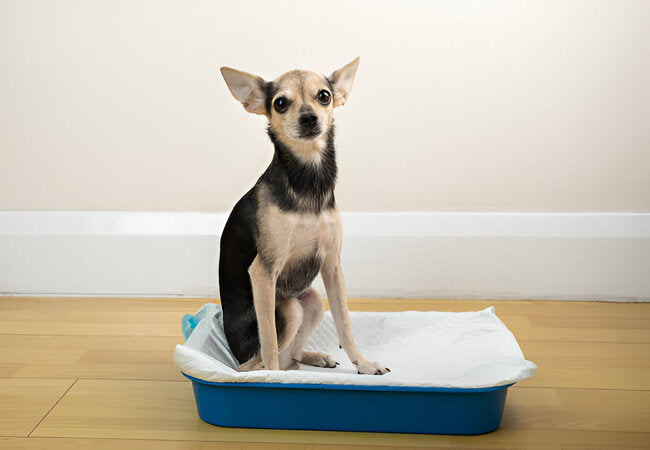2025 Vet Blueprint: How to Potty Train a Puppy 🐶🚽

In this article
2025 Vet Blueprint: How to Potty Train a Puppy 🐶🚽
By Dr. Duncan Houston BVSc
Hello, I’m Dr Duncan Houston BVSc, veterinarian and founder of Ask A Vet. Potty training is one of the first—and most important—skills your puppy must learn. In this 2025 guide, I’ll walk you step-by-step through proven, vet-approved strategies to train your pup quickly, respectfully, and effectively. With consistency and patience, your puppy can be house-trained in as little as one week to a month! 😊
1. Start Early: Ideal Age & Timing ⏰
Begin potty training when your pup is between 8–12 weeks old. At this age, they’re cognitively and physically ready to begin holding their bladder for longer periods.
- Puppies can typically hold their bladder for one hour per month of age (e.g. 2‑month puppy = ~2 hours).
- Expect accidents during learning—this is normal and part of the process.
2. Establish a Routine
Consistency is key. Tie potty breaks to life events:
- After meals or drinking
- After napping or play sessions
- First thing in the morning and right before bedtime
- Every 30–60 minutes initially, then gradually increase intervals.
This predictable structure helps your puppy associate a specific location with elimination.
3. Master Crate Training
Use a crate as a learning aid—not punishment:
- Introduce it gradually with the door open.
- Keep crate size appropriate—big enough to lie down, small enough to discourage elimination inside.
- Use crate time when you can't supervise—dogs naturally avoid soiling their den.
- Avoid leaving puppies unattended for more than their bladder can hold.
4. Recognize Pre-Potty Signals
Puppies often show subtle behaviors before needing to go:
- Pacing, sniffing, circling, whining, heading toward the door or your leash.
- Standing still or losing focus during training.
Watch and respond quickly—learn their signals to prevent accidents and reinforce correct behavior outdoors.
5. Praise & Reward Immediately 🎯
Timing is everything. When your puppy eliminates outside:
- Praise enthusiastically (“Good potty!”) right away.
- Follow up with a high-value treat as positive reinforcement.
- Associate a cue word like “go potty” said right before they eliminate—this builds future cues.
When accidents happen:
- Never punish your puppy—this causes fear and confusion.
- Clean messes with enzyme cleaner to remove scent cues.
6. Use a Designated Elimination Spot
Always lead your puppy, on leash, to the same spot to maintain consistency. Stick with it until elimination occurs, then praise and treat.
7. Track Progress & Adjust 🗓️
Logging elimination helps spot patterns:
- Use a notebook, whiteboard, or app like “Puppy Potty Log” to record feeding, drinking, peeing, and pooping.
- Identify emerging schedules and refine potty intervals accordingly.
8. Gradually Expand Access
Once your puppy reliably eliminates outside and holds overnight (4–6 h), you can:
- Expand crate time to longer periods.
- Add supervised access to other rooms.
- Avoid free-roaming during inconsistency—keep supervision tight.
Consistency is key—everyone in the household must follow the same routine.
9. Handle Setbacks with Patience
Accidents may happen during:
- Routine changes like travel or moving.
- Illness or teething discomfort.
- Stress or environmental changes.
Revisit core steps—more frequent potty breaks, crate supervision, consistent rewards, and no punishment—and consult your vet if accidents persist.
10. Celebrate Success!
Graduation from potty training is a big milestone:
- Expand privileges gradually—more time and space, but continue good habits.
- Maintain routine and reinforcement during critical times like travel or diet changes.
- Use interactive products—like indoor grass pads—if access to a yard is limited.
Quick Reference Chart
| Age | Max Crate Time | Potty Interval |
|---|---|---|
| 8 weeks | 1 hour | Every 30–60 min |
| 12 weeks | 2 hours overnight | Every 1–2 h |
| 4–6 months | 4–6 h overnight | Every 2–4 h |
FAQs ❓
- How long does it take to potty train?
- Many puppies get house-trained in 1–4 weeks, but full mastery may take several months.
- Should I punish accidents?
- No punishment sets back training and causes anxiety. Focus on praise for success.
- What if my puppy urinates in the crate?
- Crate size may be too large. Reduce it so they don’t want to soil their resting spot.
- Can I use pee pads?
- They may help temporarily (e.g., for apartment living), but can hinder outside training. If used, treat it like a step toward outdoor training.
Ask A Vet Support Tools & Products 🧩
Ask A Vet app offers:
- 24/7 vet chat for real-time troubleshooting
- Potty training trackers and reminders
- Product suggestions: training bells, artificial grass mats (via Purrz), and harnesses/leashes (Woopf)
Final Vet Wisdom 🏁
Potty training your puppy is a journey in trust and routine. By starting early, using crate training, observing signals, offering consistent praise, and tracking progress, you’ll set the foundation for a happy, accident-free life together. And remember: support is just a tap away with the Ask A Vet app—so you’re never alone in this journey. 🐾💙






